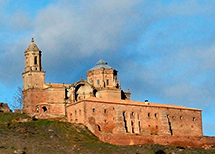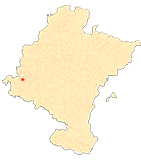Saint Gregory of Ostia
Basilica
After the reportof the Saint was lost for two centuries, in the mid-13th century the bishops of Pamplona and Bayonne, Pedro Ximénez de Gazólaz and Sancho de Axco, saw some miraculous lights that revealed the body of San Gregorio in Sorlada, in the place where, according to tradition, a mule had deposited it. At that time a church was built in his honour, which was subsequently remodelled at the end of the 17th century and throughout the 18th century, giving rise to the building we know today. Thus, in 1692 Vicente de Frías contracted the construction of the great doorway and the renovation of the nave, whose vaults were decorated with sgraffito vegetal plasterwork by Juan Antonio Jiménez and Juan Ángel Nagusia, hidden today by the neoclassical vault. A few years later, in 1718, construction began on the tower, at positionby Juan de Larrea and Lucas de Mena. Work on the church building continued in the second half of the 18th century, when between 1758 and 1764, the chapel and Wayside Cross were built, one of the most theatrical in Navarrese Baroque, following the designs of the Carmelite friar José de San Juan. The stonemason José del Castillo, the masons Miguel and Juan José Albéniz, and the plasterer Juan José Murga were in charge of the work, and the gilding of the plasterwork was carried out by Santiago Zuazo in 1765. Finally, in 1831, the nave was renovated, with new roofs with neoclassical fresco decoration. Thus, in the church the Baroque of the first half of the 18th century coexists with the Rococo of the second half, to which the Neoclassical decoration of the nave is added. Despite the work carried out in the 19th century, San Gregorio Ostiense is one of the most outstanding and monumental examples of Navarrese Baroque.
BARRAGÁN LANDA, J.J., "Las plagas del campo español y la devoción a San Gregorio Ostiense", in Cuadernos de Etnología y Etnografía en Navarra, n 29, Pamplona, 1978.
CRUZ VALDOVINOS, J.M., "Historia de la platería en la basílica de San Gregorio Ostiense", in Príncipe de Viana, n 163, Pamplona, 1981.
GARCÍA GAINZA, Mª.C. and others, Catalog monumental de Navarra. Merindad de Estella, Volume III**, Pamplona, 1983.
GARCÍA GAINZA, Mª.C., "Arca-relicario de San Gregorio Ostiense de Sorlada", in FERNÁNDEZ GRACIA, R., (Coord.) Pamplona y San Cernín 1611-2011. IV centenary of the city's vow, Pamplona, 2012.
MADRAZO Y KUNTZ, P., Navarra y Logroño, Barcelona, 1886.
MIGUÉLIZ VALCARLOS, I., "Medallones relicarios de origen lombardo en una pieza de orfebrería navarra: el arca relicario de Sorlada", in OADI. Osservatorio per le Arti Decorative in Italia, no. 6, Palermo, 2012.
PASTOR ABAIGAR, V., Fábrica de San Gregorio Ostiense. Basílica y Hospedería, Government of Navarre, Pamplona, 2015.
SALAZAR A. de, Historia de San Gregorio de Piñalva, Obispo de Ostia, Cardenal de la santa Iglesia de Roma, y su bibliotecario y bequest à Latere, Pamplona, 1624.











